Do you have a friend who says he’s going to start a business?
But after months… nothing happens.
We call them wantrepreneurs. They love to talk about starting businesses but you and I both know that it’s all talk and no walk.
Instead, you should only listen to people who have actually started and grown a business.
In the next three weeks, I’m going to share with you the real-life business stories of three successful ecommerce entrepreneurs.
%(tableofcontents)
You’ll learn how these entrepreneurs validate their ideas, develop their product, and ultimately launch and market their business.
Ready? Let’s dive in!
Week #1: $175k Total Lifetime Revenue Selling Cricket Protein Powder (CRIK Nutrition)
Alex Drysdale from CRIK Nutrition developed a protein powder made out of crickets.
Alex bootstrapped his business using a small amount of his savings and launched through Indiegogo.
Since then, he has let sales organically grow as he adjusted the product based on customer feedback. Alex has only run two paid marketing tests for a total of $1,700 that brought in just under 10x ROI.
Since the successful Indiegogo campaign (raising $16,428 CAD, $6,428 more than the $10,000 CAD goal), sales doubled organically year over year, and to-date, CRIK Nutrition has made a total lifetime revenue of over $175,000.
Quick stats:
- Product: Cricket Protein Powder
- Founded: 2015
- Location: Winnipeg, Canada
- Lifetime revenue: $175,000+
- Founders: 1
- Employees: 0
Now let’s dive into Alex’s story! Take it away, Alex…
How It All Started
Prior to starting CRIK Nutrition, I was spending most of my time in Europe being mentored in ecommerce by some friends of mine.
It was one morning when I was in Canada, I was flicking through Facebook and saw an article that Tim Ferriss posted about cricket protein bars that garnered a lot of investment.
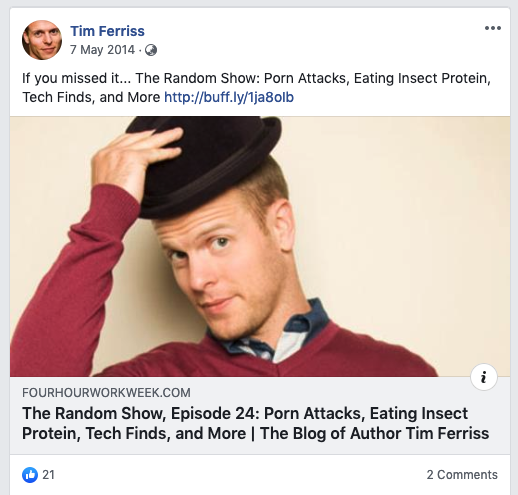
It was kind of odd but Tim Ferriss is often quite on the ball with all the new things, so I decided to give it a look. Within two paragraphs, I was blown away by the benefits and sold on the idea right on the spot.
I don’t really ever eat protein bars, but I wanted to give cricket protein a try. So I looked up where the protein bar company got the crickets for themselves — to see if I could use them in a protein shake or smoothies.
Then I ordered some crickets for myself.
I also looked online to see if there was anybody actually making a cricket protein powder out there because I wanted to use it myself to replace the protein powder I was using. I couldn't find anybody online.
There were a couple of businesses talking about it, but nobody had actually made an actual working prototype or had sold any cricket protein powder.
From Mixing Ingredients In The Kitchen To Doing Taste Tests At Crossfit And Bodybuilding Events
It started with me ordering some grounded crickets from the farm I mentioned above. I actually called them and talked to them about my idea. They really liked it and sent some products over.
While waiting for it to get shipped, I went to buy some other ingredients like raw proteins, Stevia, cane sugar, vanilla, all these different things I thought could make it a good, mixable, ready-to-drink protein powder.
Then, I was grinding up different ingredients with crickets using my coffee grinder at home. In the meantime, I also used it in my smoothies.
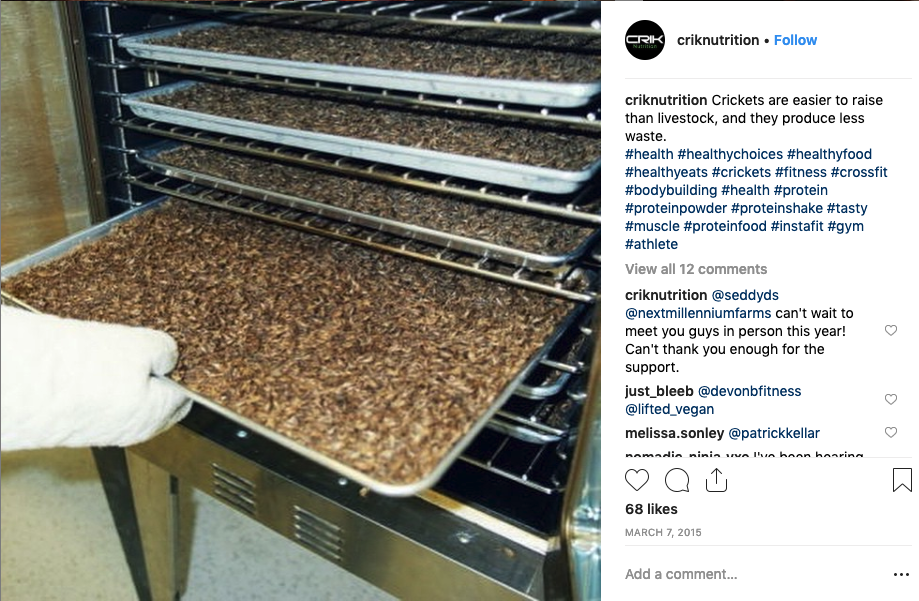
When it came time to turn this into a business, I realized I had something that I liked. To be exact, it was when I saw all the steam that was picking up in the cricket industry for edible insects.
I got on Google and searched how to manufacture protein powder. Then, I spent a few days on there just learning all I could and getting different numbers for different factories and brands.
As soon as I had a big sizable list, I got on the phone and started calling people one after the other for about two weeks straight. There was a lot, a lot, a lot of rejections.
Eventually, I got a slightly better response from the last person on my list. They didn't want to work with me either, but they said they had a factory they knew down the road that might be interested in working with me. And sure enough, when I gave them a call, they were really interested in it.
It took me a while to get on the same page with the manufacturer. But once we did that, we sent some samples back and forth, and I tried them all myself.
Whenever I found cricket protein powder formulas I liked, I got my friends and family to try them. We slowly narrowed that down to something I thought would be commercially viable that the general population would like.
From that point on, I ended up going to a couple of different CrossFit events and bodybuilding competitions. I got a booth and set it up to do taste tests.
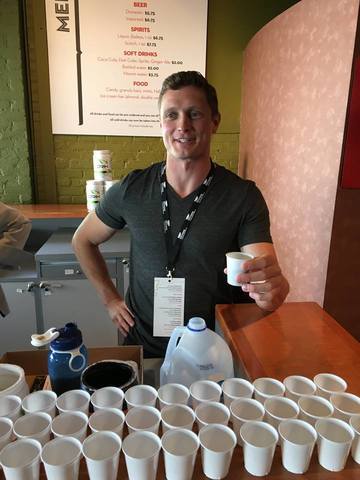
I wanted to see the reaction from other people.
Some of them actually suggested that I keep the ingredient secret during the taste tests, but I think some people could have got angry if they didn't know what it was or if they had different allergies with crickets.
So I told people what it was and that I wanted to get their feedback. The feedback I got was really good.
Here’s a video of Bodybuilder Rich Piana testing my cricket protein:
Here’s some Crossfitters taste testing my cricket protein:
I had the samples now, good feedback from my market, and wanted to move forward with the formula. Every time I made an order from the manufacturer, I used the feedback from customers to improve the product.
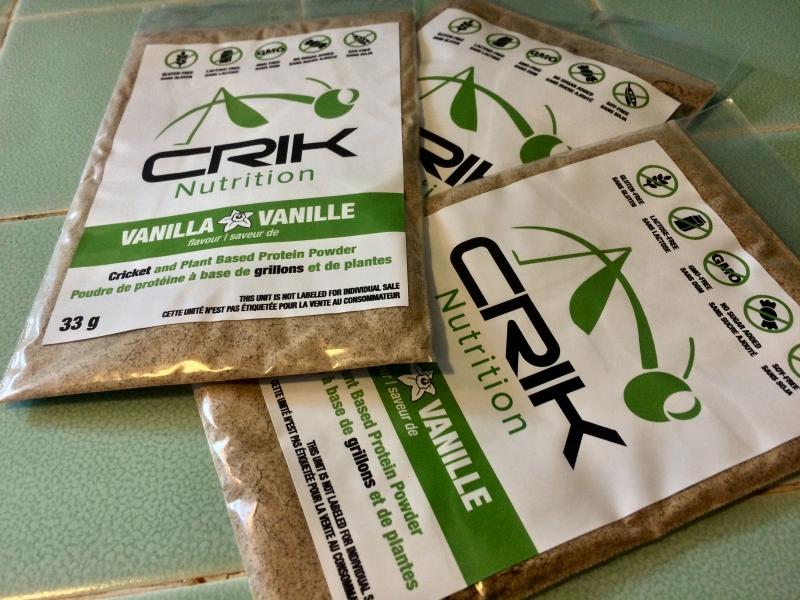
Got Banned By Kickstarter And Missed The Launch Date
In April of 2015, I made a whole campaign ready to go on Kickstarter. It was set to launch on Earth Day (April 22).
With no reason, the campaign got banned the night before launch. I didn’t know what happened, and it was frustrating because I had a lot of media attention on it as all the articles went live prior to the launch day.
Kickstarter banned the campaign and said they wouldn’t sell protein powder, and they only gave me about 120 to 200 characters to rebut their decision. So I sent them three links to other protein powder campaigns, and they banned my account.
I panicked a little bit, but then quickly pulled it all together and made a new account on Indiegogo.
I didn't get the Indiegogo campaign done in a day and missed the target launch date, which sucks because I missed a lot of traffic because of that.
Worse, I wasn’t able to get ahold of anybody at Kickstarter. To be honest, it was pretty annoying. And working with Indiegogo was a lot smoother and a lot nicer. They have much better customer service.
Fully Funded In A Day And 164% Funded By The End Of The Indiegogo Campaign
I didn’t have a huge goal. The goal was to hit $10,000. If I could hit $10,000 selling the product to strangers that had never seen or tested it, I felt comfortable enough using some of my savings to create my first run for the product.
During the launch, I spent all day on the phone, promoted the campaign on Facebook, Twitter, and all the social media channels. I also emailed everybody who I knew and asked them: “Hey, if you're interested, please check it out. And if you kind of like what we're doing, please share it.”
The campaign ended up getting fully funded on the first day.
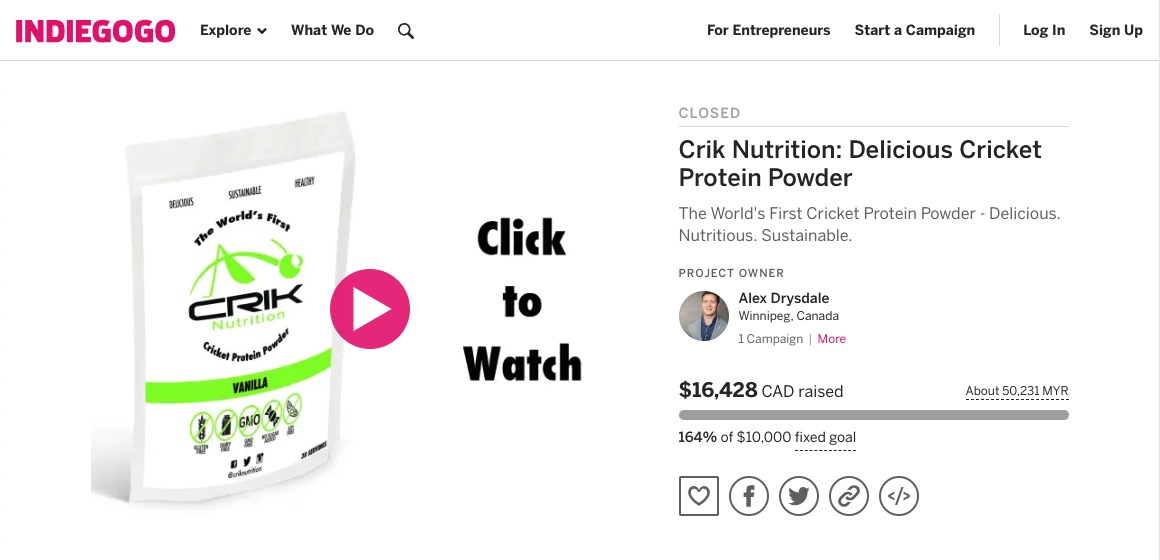
The product did really well on Indiegogo and made it to the front page of the food category throughout our whole campaign. At the end of the campaign, it had raised $16,428 CAD.
On my end, it cost somewhere around $25,000 to start manufacturing it.
The campaign ended in June and I shipped out in November. That was a small batch of product where I used what I learned from the customers after the first batch to improve the taste.
I made some tweaks such as making it less sweet and created a second flavor. I also changed the serving size to match some other bigger protein powder brands out there.
It wasn't perfect, but I got it shipped to get the product out there. To me, the main thing was to make sure the product tasted good and provided the benefits the customers were looking for. As long as it met those, I wanted to get it out the door because I knew I could tweak things based on what customers liked later.
The Three Best Marketing Channels For CRIK Nutrition
Organic Search
The biggest marketing channel for CRIK Nutrition has been organic search traffic. I really focused on making sure the brand ranked on Google.
I noticed all the other companies that had started before me were really focusing on paid advertising, so there wasn't much competition at the beginning.
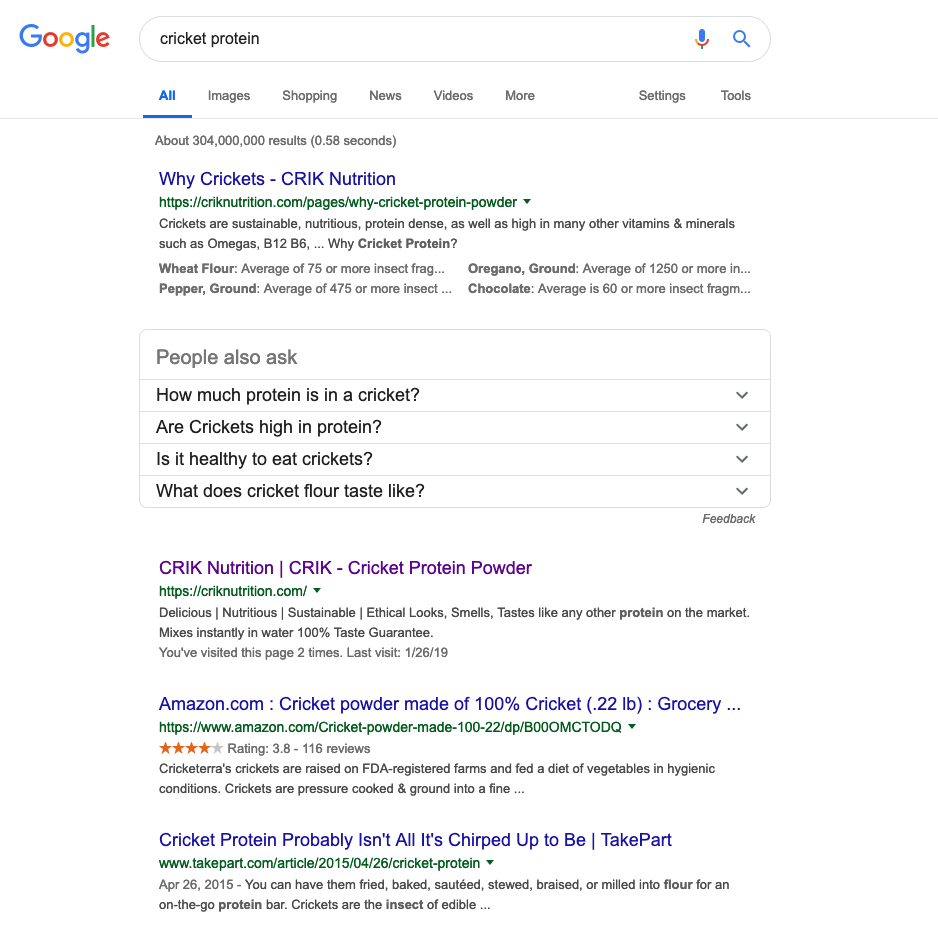
They weren't focusing on organic search results because there weren't that many people searching for cricket protein powder three years ago. But I knew from the trends that eventually there would be more and more people starting to search for cricket protein and cricket protein powder.
Besides, I didn't have a budget for marketing or advertising so that was kind of my go-to. We got a lot of really good traffic on our Indiegogo campaign so I utilized that by pointing it towards our homepage and all of our social media accounts. That really helped us propel and stay up in the number one and two spots on Google.
Word of Mouth
Beyond that, it's been word of mouth through our customers and by doing what we say we do, making sure that cricket is the number one ingredient when people are buying a cricket protein powder.
My approach is to make a really good-tasting product and provide the customers a great customer service.
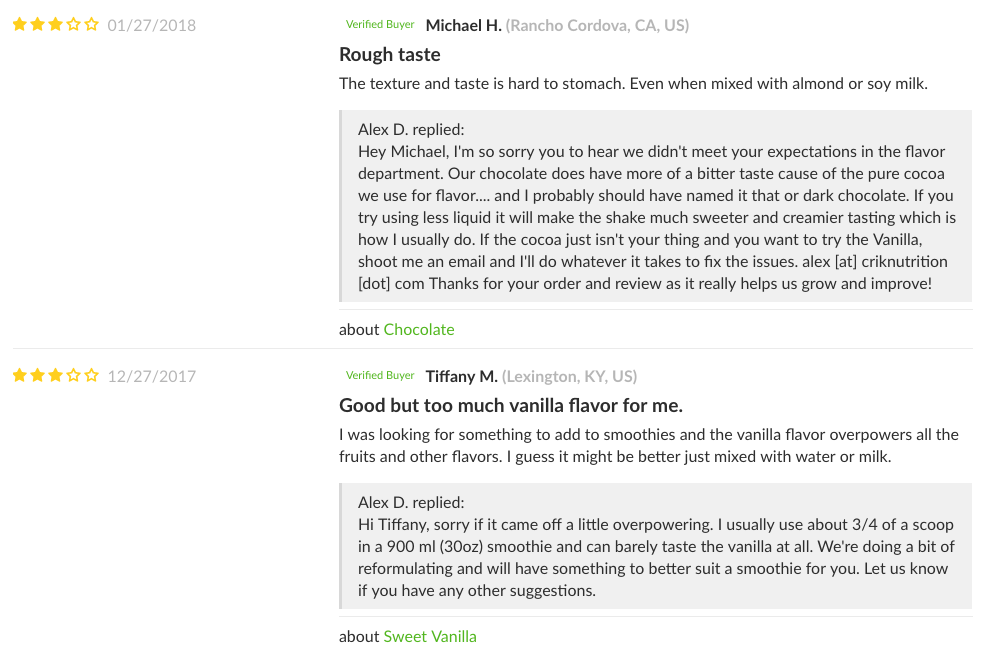
Sometimes we get aggravated customers that are having a bad day, or they want to cause problems for whatever reason. But if you feel like writing a nasty email, put it aside and try to be as nice as possible to them because there could be other things going on.
In my opinion, when people make nasty comments, they're usually not trying to troll you. It's likely they feel this way and are upset. We've all been in that position as a customer before. Maybe the shipping company wrecks the package, who knows, right? You've got to be sympathetic with your customers, provide them with really good service, and give them what they want no matter what that is.
There have only been a couple times where I reached out because I really felt the customer was being unfair. I called them personally because they had provided me with their phone number and are open to communication. So I reached out to them and tried to learn more. It turned out they were having a bad day and we got it all figured out at the end.
Influencer Marketing
Besides SEO and word of mouth, I did a couple little marketing and advertising tests too. The biggest thing I've seen that is way head and shoulders for attracting customers is working with influencers and people who have an audience.
The key is to only work with influencers that truly believe and support your product.
When they're talking about your product, the audience can really tell the difference whether somebody is advertising versus supporting and putting themselves behind a product.
The Biggest Mistake Made Growing CRIK Nutrition
My biggest mistake was focusing on retail.
I've had big success when it comes to doing things that scare me. There’s kind of a fine line to know whether you don't want to do something because you're afraid and fear of the uncertainties, or whether it's your intuition telling you:
“Hey, maybe you should sit down and go through the numbers or really look into this further before committing to it.”
The brand had a lot of attention coming our way from some retailers. And at that time, I didn't know anything about retail.
So I spent a year flying around, meeting with people and taking advice from people that have been in the supplement industry for decades. And quite honestly, I went against my gut.
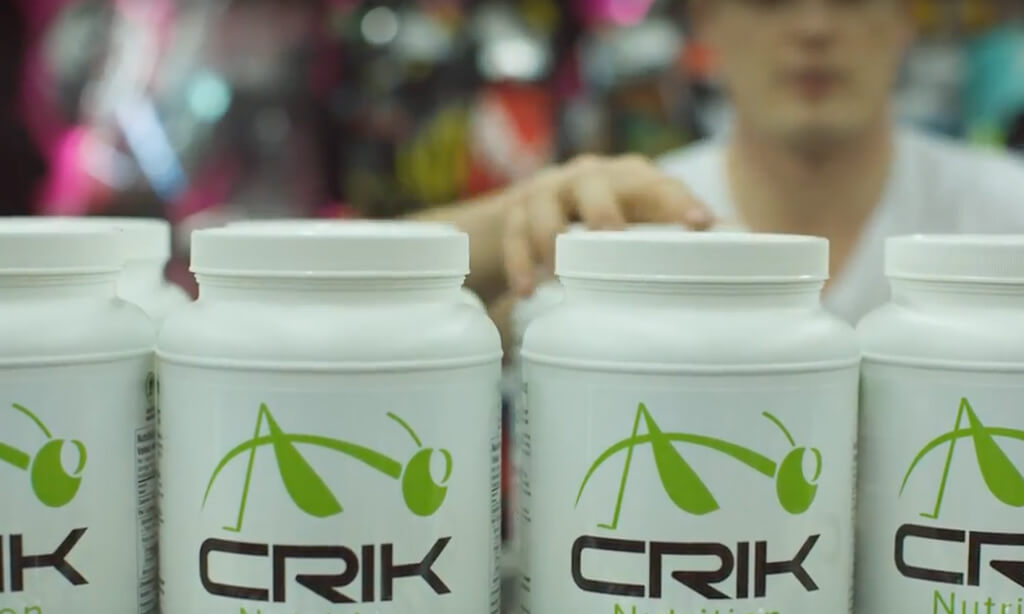
When I was looking at the traction some competitors were getting from retail, I got over my head and made bad decisions based on that. I didn't really understand the retail space and it almost caused me to fail at a level beyond something I could repair.
In reality, I should have focused on online and managed my inventory levels.
I did learn a lot and probably more than what I would by going to a university for two or three years. I don't regret it. But when I look back, I wish I would have trusted my gut.
I spent last year reading and getting coaches to help me refocus on my intuition and learning to trust that gut feeling when it comes to my business.
The Most Influential Resources To Alex And CRIK Nutrition
I can rap off a bunch of books and resources for weeks, but here are a few that I recommend everyone check out.
Books
- Think and Grow Rich by Napoleon Hill
- Meditations by Marcus Aurelius
- Built to Sell by John Warrillow
- The E-Myth Revisited by Michael E. Gerber
- The Automatic Customer by John Warrillow
- Expert Secrets by Russell Brunson
Podcasts
Resources
- Sumo’s blog
- QuickSprout and Neil Patel[*]
- Digital Marketer[*]
Alex’s Advice For Aspiring Entrepreneurs
Be an Independent Thinker and Trust Your Gut
Taking my experience of diving head-on into retail, it’s still important to take advice from people that are more experienced and more successful than you. But at the end of the day, they don't know the nuances of your personal finances and your business.
Because of that, they end up giving you a very coarse bit of advice, and you need to sometimes fine tune that. I think it's really important to focus on your intuition, your gut and trust yourself. That's something I’ve spent a lot of last years working on for myself.
Be Coachable and Never Stop Learning
When somebody gives you advice, make sure you follow it and apply it. Or at the very least show them evidence of you applying it, why it worked or why not.
When somebody gives you a couple of books to read, read them and then shoot them back a little email that says:
“Hey, I read this and this, and it's great because of [insert your points]. Thanks for the advice. I applied it to my life and this is how it helped.”
A lot of people email me now for help, but most of them are going to waste your time. I used to reach out to help personally but now, I prefer to give a couple of books recommendation. If they read them and can show that they have, I will be more willing to invest more time in helping them.
Embrace and Seek Negative Feedback
It's shitty to be a customer who has high expectations and then not having those met, and worse when the brand is trying to argue with you.
That’s how I look at it, so I don’t argue with customers. You got to really take and consider their point of view, especially for feedback.
Also, I love working with people that are brutally honest because too many people are too nice, especially your friends and family. You’ve got to get people that aren't necessarily emotionally invested in your feelings or feel like they need to make sure you're happy.
For example, when I was doing bootcamps like Startup Weekend, and we got mentored by different VCs or angels, I always picked the guy that everybody was scared of. Because he/she is the person who is going to give you the real advice and he/she is not gonna be afraid to hurt your feelings. The real reason for that is they want you to be successful.
So, don't be afraid of critical or negative feedback. Even a negative person might be able to pick out things that the happy go lucky, positive people might miss.
Week #2: $40k/mo Selling A Multipurpose Mount For Tech Devices (Tenikle)
The next ecommerce entrepreneur we tracked down was Hans Dose from Tenikle.
Tenikle is a tech accessory to mount all your tech — phones, tablets, and cameras — anywhere. In Hans’ words, it’s a Swiss army knife of tech accessories.
Here are some stats on the business:
- Product: Multipurpose mount for tech devices
- Founded: 2017
- Location: San Diego, California
- Revenue: Avg. $40,000+/mo
- Founders: 1
- Employees: 3
Now let’s dive into Han’s story! Take it away, Hans…
How It All Started
I used to go on hikes with my fiance and always forget to bring a tripod to take pictures. We’d then prop up our phone against a rock or a tree, trying to take a picture.
Because of that, I always had an idea for a mechanism that could attach all sorts of accessories, like battery power, lenses, clips, mounts, wallets, etc.
One day I got pulled over, and got a ticket from a cop for looking at my phone. In fear of getting a future ticket, I went to a major tech store to buy a car mount. As I was searching to pick out the perfect one, I became disappointed that they were all the same big, boring, black mount and only did one thing!
That was when the idea hit me. I thought it'd be cool to merge the two (tripod and car mount) together so that I would never forget my tripod anymore, and also have my car mount.
I grew up surfing and always naturally inspired by the ocean. I thought octopus and starfish were really unique on how they're able to grab and hold onto things almost anywhere easily.
Inspired by that, I copied the design of the octopus. It's funny that we always boast that we patented the octopus, because it's sort of what we did.
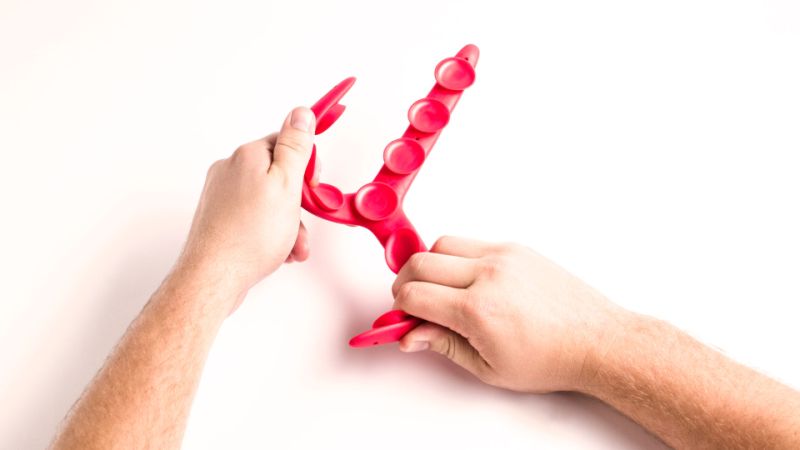
After making the prototype, I realized it does way more than those original two things I tried to have it do — grab and hold onto things.
Learning Everything From A-Z (DIY Project In The Garage)
Manufacturing the product was difficult because no one person can make the product for you. If they do, they're going to control a huge part of your business. I believed there was something special to this, so I wanted to make the product myself, and have as much control over my business as possible.
I also wanted it to be my college experience. Instead of going to school to get an MBA, I decided to start a business. What's a better way to do it than jump in and learn?
So I started by learning how to do CAD design. It was really about drawing the prototype out on 2D, making some designs of what it could look like, and then going in and 3D designing it.
Because the prototype is flexible, it needed to have different materials for different parts. So I would only 3D print the actual mold itself instead of the prototype. Then, I would go to art stores, buy some art silicone, and make it in the garage.
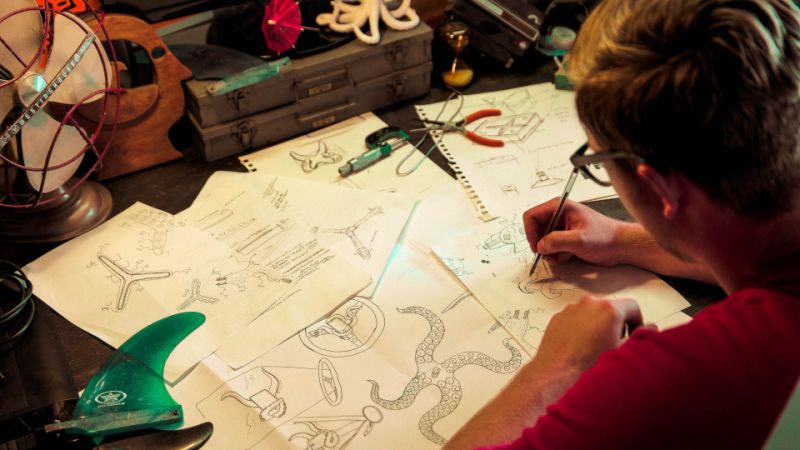
It was a full DIY project in the garage, with vacuum chambers and gassing material. It was really fun, especially when I got into the science of it.
That was the early stage of coming up with the actual product. It's one thing to make a prototype, but another to take it to mass production. Mass production required a lot more engineering. So once I had a prototype, I started taking it to manufacturers in San Diego, got some quotes in, and tried to figure out how to manufacture it.
I started working with a manufacturer on that, and then started to market and sell it.
Overall, the prototyping and engineering of the product was very much DIY. Put your head down, do it, and keep going. I failed a lot. I came up with a lot of lousy prototypes. But eventually I got one that worked, and that’s when I realized:
“Okay, I can make this thing work!”
Taking A Unique Approach To Crowdfunding Through Kickstarter And Indiegogo
I started with crowdfunding, mainly through Kickstarter and Indiegogo.
Due to the nature of the actual product, I couldn't really show a good prototype without getting some production tooling done beforehand. There’s a lot of mechanics to the nature of the actual suction cups that needed to work correctly in the first round.
So I went and got a business loan ahead of time to purchase the molds for the crowdfunding campaign. Which was a big gamble, and a huge risk. But it forced me to make sure the Kickstarter and Indiegogo campaigns work because I needed them to now.
I was in debt with these molds, and I had to pay it back somehow. So the biggest focus for me during the crowdfunding campaign was to make a really compelling video to promote the product.
Most Kickstarter campaigns are made using a similar video formula:
- Introduces themselves.
- Talk about their mission.
- Say what they do.
I really wanted the product to speak for itself. I wanted to show the versatility of how Tenikle can work in all different situations, and overwhelm the customer in a way.
Here’s the final video I created:
Instead of talking about myself too much, I showed the product in action.

Then there was a short section in the Kickstarter page that said “Hi, I'm the inventor. And this is Tenikle.” I didn't want to talk too much about me. I wanted it to be about the product.
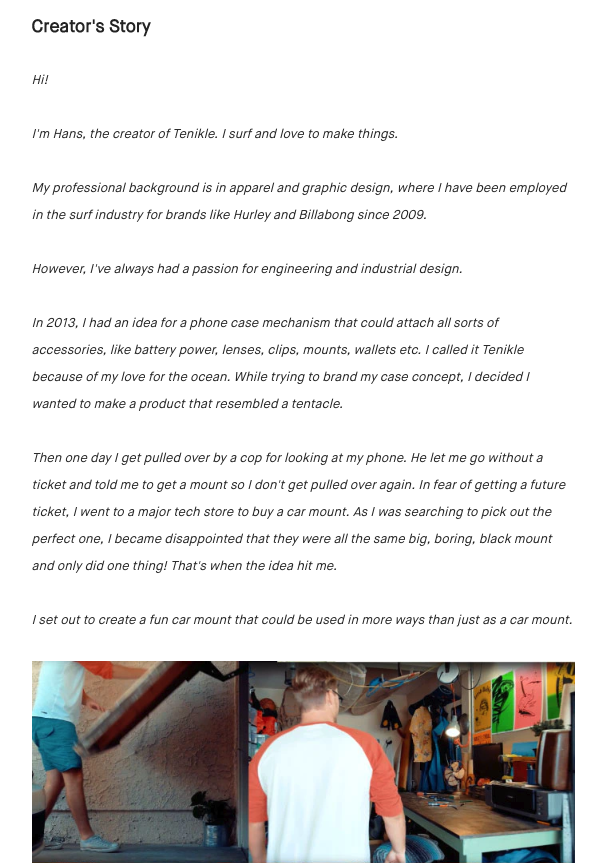
That format for my Kickstarter and Indiegogo pages ended up doing really well. And people got excited about the product because I already had the molds done.
A lot of times, creators on these crowdfunding campaigns don't realize that they're going to hit all these engineering speed bumps along the way. So getting the molds done ahead of time is helpful.
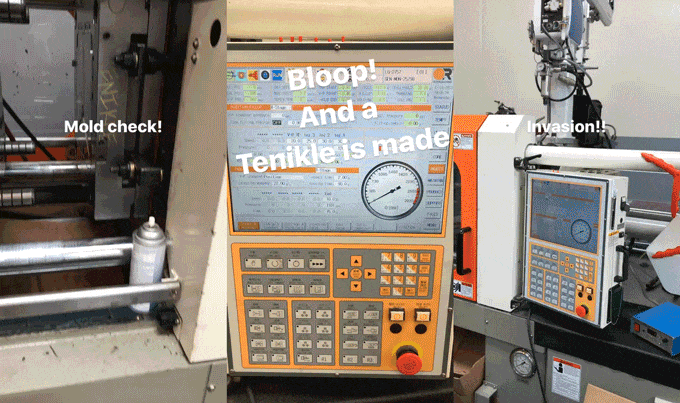
Yes, it was a lot riskier upfront making the molds, but it allowed me to promise all the backers that the product will get made and delivered on time.
It turned out to be a great success. Tenikle got more than 710% funded, raising $107,000 on Kickstarter, and $126,000 on Indiegogo.
It was a very backward way of doing it compared to most Kickstarter campaigns. But that's how I did it, and it ended up working. It probably wouldn't work 100% of the time, but it worked out this time.
Besides that, our crowdfunding campaign was probably one of the fastest to ship the product. We launched in August 2017, and we shipped everything before the December 2017 holidays. So we got all of our orders out in time for the holidays, and that was pretty cool to be able to do that in that short amount of time.
Content Is King And Video Content Is The New Leader
The strongest marketing channel I’ve come across so far has been a really compelling video, and using that across as many platforms as possible.
Facebook and Instagram marketing has been our primary focus. We've also done YouTube ads, but we took a break from that while developing Tenikle 2. We're going to jump back into some more videos soon.
Everyone says content is king and video content is the new leader, and that's absolutely true. It’s about making a short, concise but clear video on what the product is, and at the same time not making it too salesy.
One of our most successful videos was a video that says “This is Not a Fidget Spinner.” It was coming off the trend of fidget spinners. It stuck really firmly in the trend, and we use that as a plug in the first couple of seconds to grab people’s attention.
Here’s one of our Facebook ads advertising the video:

It’s also important to NOT make the video too infomercial-ly. You have to add value to keep people watching your videos. Telling people about your product isn’t going to add enough value, so sometimes it needs to have a little bit of humor, and be light on product promotion.
People may or may not buy the first time around, but you can always retarget them in the future, and start winning them as a customer.
Once you have them as a customer, you can start retaining them better using emails and other outlets. But I'd say the biggest one for us is video ads.
The Future = More Video Content + Better Product (Tenikle 2)
Right now, we’re looking into investing more in content marketing, especially videos because it’s what works for us.
We also launched Tenikle 2, an upgraded version of the original Tenikle based on user feedback.
We went back to the drawing board to develop the product using a different mechanism and materials. It’s way more flexible, and the suction works better compared to the original Tenikle.
The original Tenikle got 3.6 stars out of 5 in reviews, while Tenikle 2 is getting 4+ stars so far.
The Most Influential Resources To Hans And Tenikle
[Podcast] Business Rockstars[*]
To me, this podcast leans towards more emotional-based storytelling. I started listening to the Business Rockstars podcast a while ago, and it was really helpful to get into the mindset of starting and running a business.
[Podcast] Mixergy by Andrew Warner[*]
I really like this podcast because it's packed full of real-world tools and insights. I ran into Andrew down here in San Diego. He was grabbing a coffee, and I approached him to say hello and then chatted a bit about business. To me, he’s a super nice guy.
[Community] SCORE[*]
SCORE is another excellent resource that a lot of people don't know about. It’s a platform that provides business guidance and mentorship programs (for free) funded by the government.
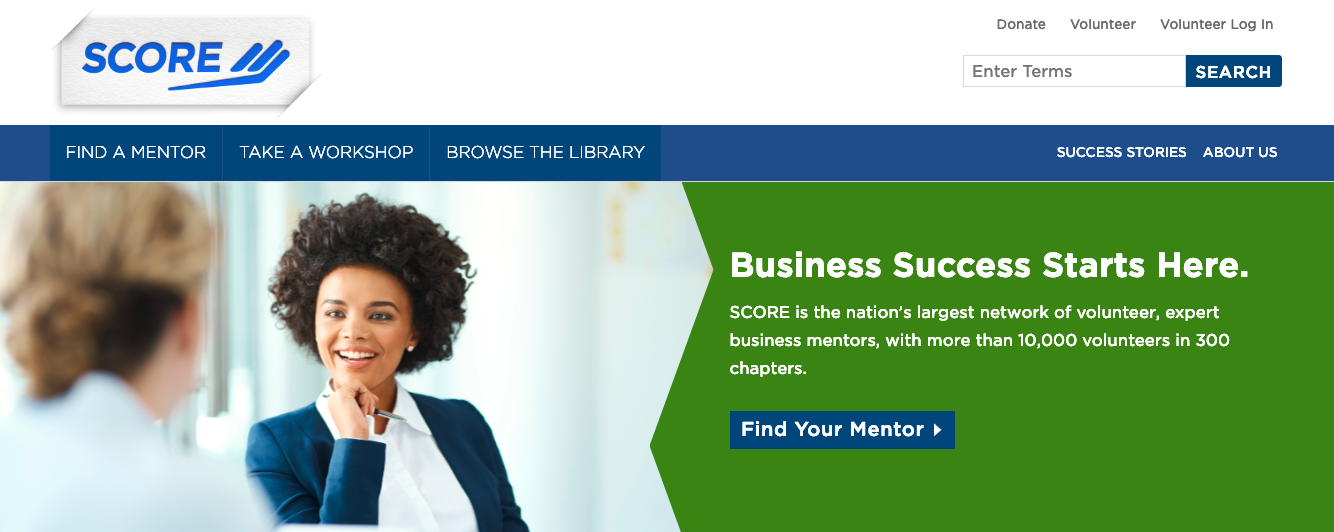
There are a lot of retired businessmen, entrepreneurs, and even sales brokers across pretty much any industry — who want to help others.
I’ve been able to find a few people here in San Diego. Two guys in particular have been really helpful and guided me through some of the things because they’ve been there and done that.
Hans’s Advice For Aspiring Entrepreneurs
Know Your Numbers And Track Them Every Month
Make an expense sheet every month and track exactly what you're spending your money on, and where the return is. I say it because it’s the one thing I didn’t do upfront, and it put me in a bit of a pinch down the line.
Ask yourself what you’re spending on and if it’s helping your business. If it's not totally helping your business, it’s time to let it go. That’s the real-hardcore, old school way of doing things.
A lot of times younger entrepreneurs get caught up in the whole startup-style business model of raising money, gaining meaningless traction, and chasing shiny tactics.
When you're in business and you're moving, there's a lot of money coming in and out. For me, it’s hard to track it all sometimes. But all you really need to do is sit down and go through your balance sheet.
I wish someone would've told me that. In business, it's one of those things you learn the hard way. But yeah, that is really, really important.
Don’t Stop, Keep Going
The number one reason why any business will fail is that it got too hard for somebody. I’d say if you’re stubborn enough to not give up and keep going when it’s hard, you will see the light at the end of the tunnel.
Even when it's easy and things are moving right, when you feel like you can settle down, there's always something around the corner that you might not be aware of. It’s critical to be on top of everything and not stop. No matter if it's hard or easy, you can't let it rest.
Week #3: $100k/mo Selling Carbon Fiber Guitars And Ukuleles (KLOS Guitars)
In week #3, we have Adam Klosowiak from KLOS Guitars.
KLOS Guitars make the most affordable, durable, and portable guitars/ukuleles. They’re built for traveling, playing at home, or any other environment.
Let’s kick off with some stats:
- Product: Guitars and ukuleles
- Founded: 2015
- Location: Salt Lake City, Utah
- Revenue: Avg. $100,000+/mo
- Founders: 2
- Employees: 23
Now let’s dive into Adam’s story! Take it away, Adam…
How It All Started
My brother Ian was studying mechanical engineering, and was in a class where they had to come up with a product that had not been made before.
He had done a lot of road biking and worked with bikes before, so he was very familiar with carbon fiber. At that point, he had also been a guitarist for about 10 years.
He found that almost all carbon fiber guitars were $1,600 or more, and realized they didn't necessarily need to be that expensive to make, if you look at all the parts.
That process was happening at about the same time my travel guitar (that he’d sold me a few years before) broke, during winter. The wood had cracked because it was too cold. Coincidentally I was also getting more into entrepreneurship at the same time, at Princeton University where I studied electrical engineering.
This was me doing demonstrates of a KLOS travel guitar during the Princeton eLab Summer Accelerator program.[*]
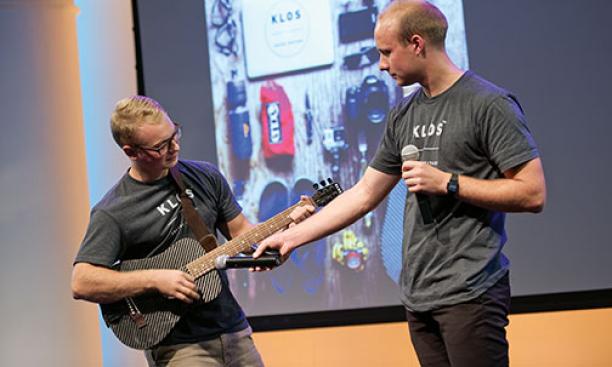
All of those factors culminated together when I was visiting Ian out in Utah one winter. That was in February 2015, and there was a business competition that Ian asked me to write a pitch for, for his prototype. We entered the competition and won $1,000, which was enough to make a second prototype, and it kind of started rolling from there.
From Prototyping For A Competition To Building Actual Products For Kickstarter Backers
There is a different mindset for creating a product with the intent of only ever making one product, compared to creating a product for mass production with the idea of scaling in mind.
For the first prototype Ian made, he didn't envision a company coming out of it at first, so sourcing and supply chain was not an element. He just wanted to get the parts he needed to make one.
For example, he bought a guitar from the pawn shop that was really cheap, took the neck off, cut the neck to the size that he wanted, and made the carbon fiber body.
There are several different processes you can use to make carbon fiber parts. One of them is having a female mold, then doing what's called an infusion process. With the female ready, we then vacuum-bag the carbon fiber layer on to the guitar. This process took many hours for Ian to make the first one.

The key difference in making the initial prototypes for the crowdfunding campaign was that instead of trying to make three, we were trying to make the actual jig and machine that would then allow us to make 70, and hundreds after that. We spent more time building the machinery to make the parts, then the actual parts themselves.
We then moved on to build up the supply chain, from finding suppliers to negotiating prices — all the elements that are part of bulk production. Which really wasn't part of the process when we were making one prototype.
We have suppliers all over the world, so for whatever part we need, we first reach out to our network. For example, Graph Tech is the biggest manufacturer of nuts, saddles, and machine heads for guitars. We met them at a trade show, so that in-person relationship existed.
We've also used Alibaba in the past to find suppliers for some parts. That would be a huge topic in and of itself about how to navigate Alibaba, and how to sample.
Essentially it all comes down to having a good understanding of what your goal is, what the product is, and what the parts are. Once you have that, you sample prototype, get a small batch order, then a bigger batch, and move forward in that direction.
Getting 224% Funded On The First Kickstarter Campaign
I truly believe that crowdfunding is one of the greatest inventions currently for entrepreneurship.
Before crowdfunding, you either had to know people or take significant risks to obtain capital. Even when you do obtain capital, you still have to find a product-market fit. You still need your first customers, and you still need to launch. Now you can do all of that at the same time on crowdfunding platforms like Kickstarter and Indiegogo.
For us, because we had a physical product, Kickstarter was a natural platform. To launch our Kickstarter campaign, we made three prototypes.
Kickstarter has a few different elements:
- The campaign page/pages.
- The video, which is a critical one.
- The distribution of your page (how you get traffic to your campaign).
For each of those elements, we were looking at the most popular Kickstarter campaigns and figuring out what they did well, and then looking at the worst campaigns and seeing what they did poorly to avoid that.
We created our page and video based on these references. For video, we watched tons of videos as we storyboarded and outlined our pitch. Once we created the campaign page and video, we launched the first campaign.
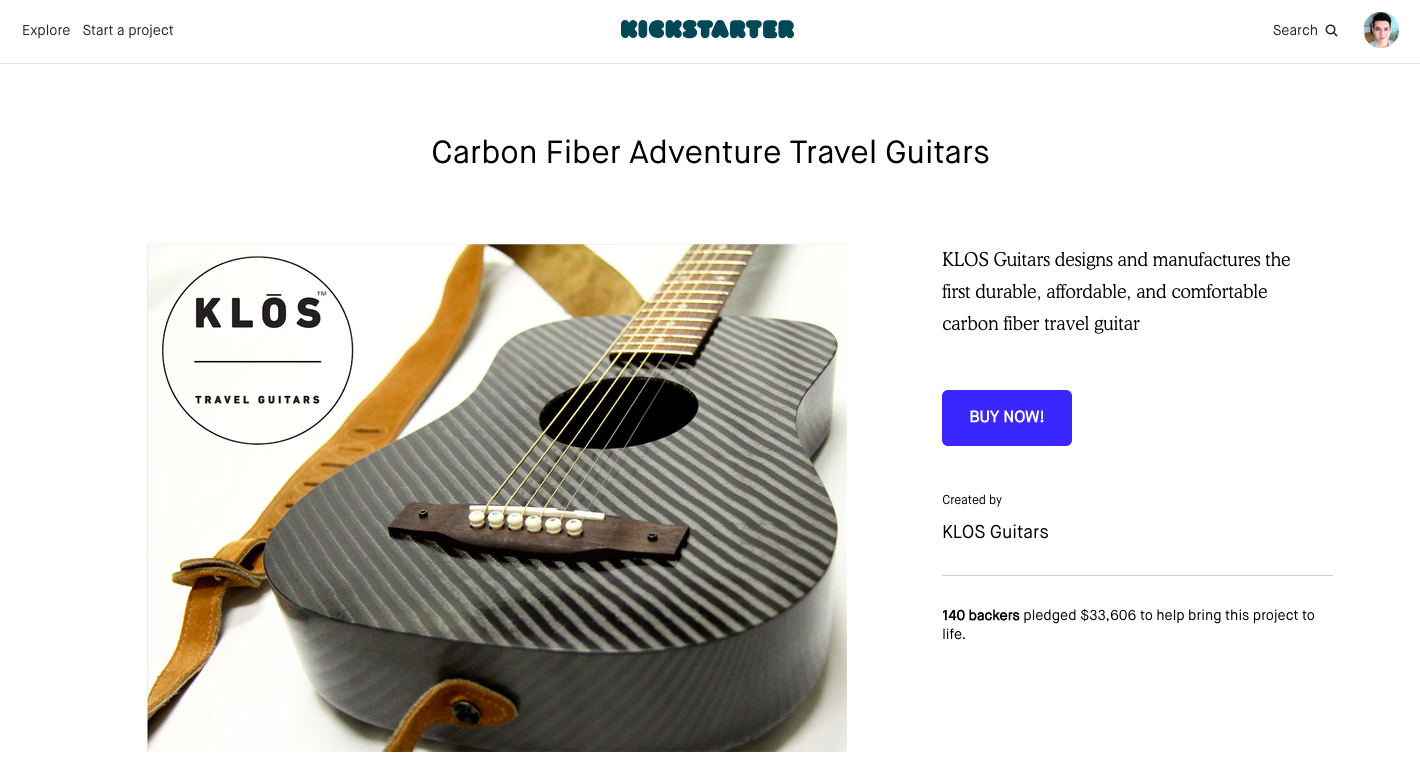
We've done six crowdfunding campaigns now and have raised over a million dollars combined.
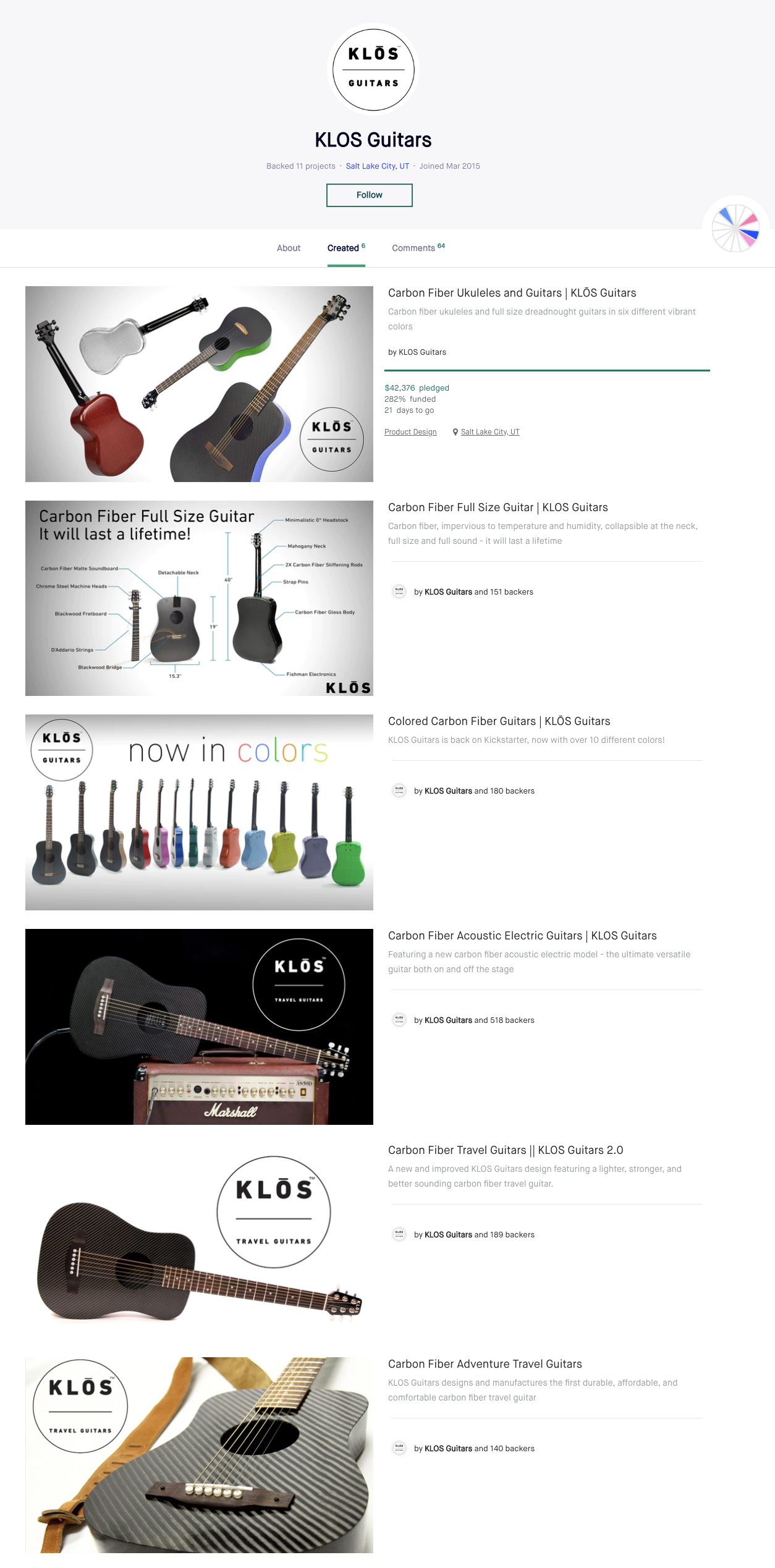
For the first campaign, we definitely didn’t know what we were doing.
We thought that if you have a good product and you launch it, everybody will magically see and know about the product, and want to buy it.
So in the summer of 2015, we launched our first Kickstarter campaign. We contacted all of our family and friends, and on the first day, we sold $5,000 worth of product. Our goal was $15,000 in 30 days. So we were feeling pretty optimistic.
Then literally for the next 10 days, there was no activity on the page at all. We started getting really worried. We thought, “You know, maybe this idea isn't that good…”
We then discovered you have to come up with a distribution plan for it — advertise it, promote it, reach out and talk to blogs, and everything else. So halfway through the campaign, we started aggressively promoting it in various ways, and that campaign ended up getting to $33,000 (with 140 backers) and 70 customers.
We worked on manufacturing those guitars for the next eight months. We were pretty late on the campaign delivery, but backers were pretty flexible and understanding. They knew that we weren't just creating 70 guitars. We were creating a system that could then continuously produce hundreds of guitars going forward.
Using Kickstarter As A Product Launch And Marketing Platform
Obviously, our product is not a recurring purchase product. We've had some customers who buy several travel guitars, but in general, you only need one travel guitar for yourself. So for us, the more important part of the question is the initial acquisition.
There are two types of campaigns in crowdfunding.
- One-off campaigns. Where someone does one campaign for their first product. Then once they’ve finished with the campaign, they're done.
- Product launch campaigns. Where people treat crowdfunding as a product launch platform for every new product they create (not just the first).
For us, we now treat it as a product launch platform because there's a thriving community there that gives feedback.
Here’s a video we made for one of our Kickstarter campaigns:
There are early adopters in these crowdfunding platforms, and they want to be the first to have the product. So we're always going to continue using crowdfunding as our testing ground for new products and new customers.
For our website, we generally promote it via Facebook and Google. Those are the two main advertising channels we use. Both those platforms reach hundreds of millions of people, so they’re great tools to drive traffic to our store.
Here’s an example of one of our Facebook video ads:
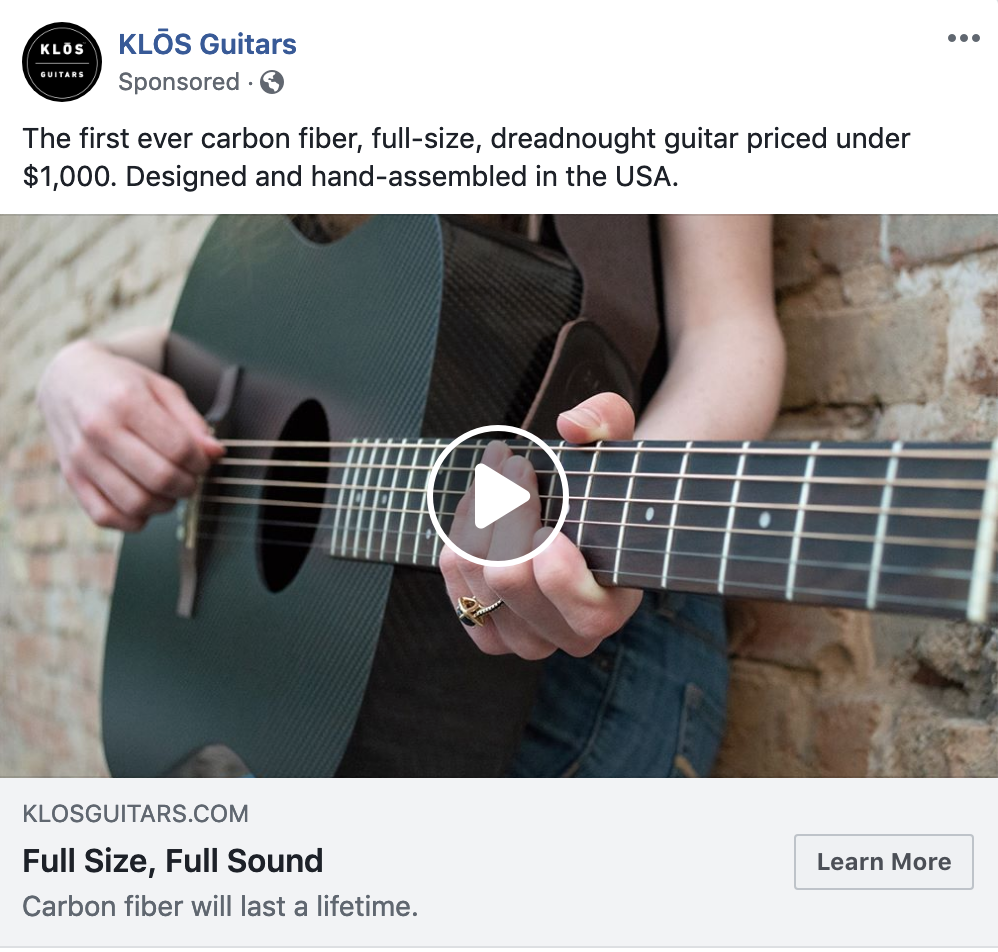
In addition to that, we also reach out to blogs that write about guitars. As we get bigger, there's more word of mouth traffic and traction.
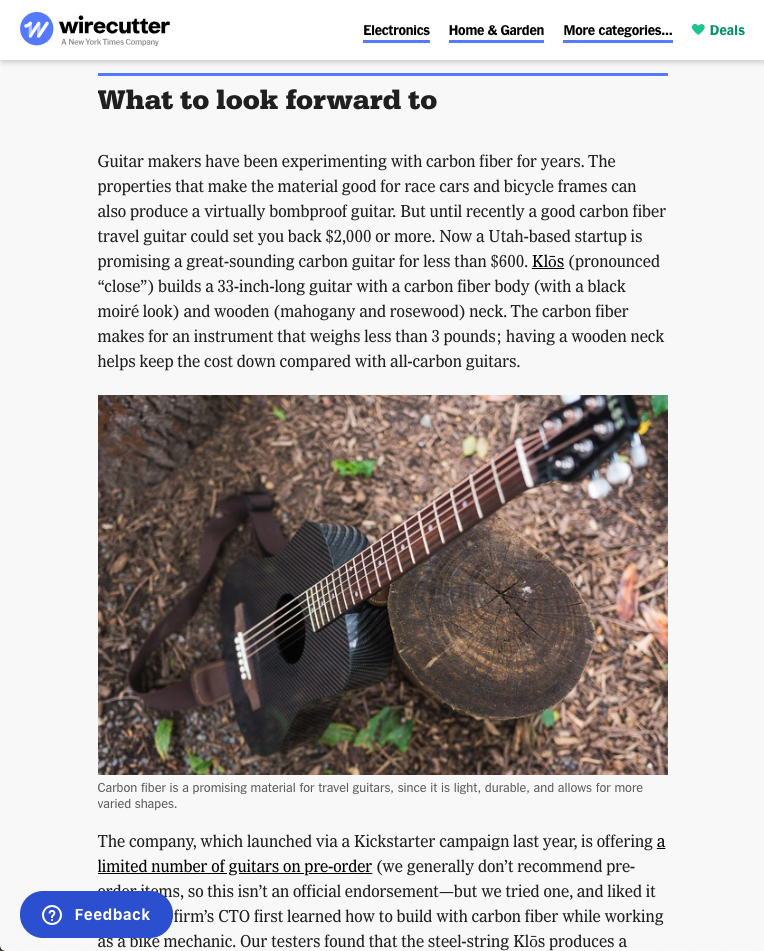
Seeing Retail As A Huge Growth Opportunity For The Years To Come
We've been growing pretty fast. In 2018, we broke the $1 million mark in sales. That’s 30x growth in four years since raising $33,000 from our first Kickstarter campaign in 2015.
We’ve refined our products consistently since the first launch in 2015. We truly think we have the best travel guitar out of all the competition. And our ukulele is one of the nicest ukuleles you can get in the market. Also, our third product (the full-size guitar) sounds amazing. So we’re really happy with the quality of the products.

For now, we’re going to keep introducing new products. We have a few different products we’re thinking about this year. They’re still not polished, so I won’t say which ones they are, but we do have some very exciting new instruments coming.
As for marketing, we’re exploring some retail strategies, like going to stores and partnering with them. It’s a new initiative that we’re starting this year. From what we’ve learned, instruments are very physical products. Most people want to pick up the instrument, and see how it feels, looks, and sounds. So there are definitely objections and challenges when we’re selling online.
Although we’ve had good success online, the reality is that the bulk of sales (in the instruments industry/market) still happen in stores. So it’s a big opportunity for us to go to retail.
Another thing is there's a belief that direct-to-consumer online has a much bigger profit margin than retail, and that's definitely the case for some products. But for many products the cost of customer acquisition online is significant, and often that cost is not that much smaller than a wholesale discount to a dealer.
So we’re starting to explore the retail strategy. We think it could be a great addition to our business and won't impact the profitability of the product necessarily.
The Most Influential Resources To Adam And The KLOS Guitars’ Team
[Podcast] Masters of Scale by Reid Hoffman[*]
One podcast on the business side that I've enjoyed listening to is Masters of Scale by Reid Hoffman, the former founder of Linkedin. He talks about scaling businesses, so that's always exciting to listen to.
[Book] The Goal by Eliyahu M. Goldratt[*]
The Goal is a great book on manufacturing. It presents the challenges and bottlenecks in manufacturing, and how to overcome capacity constraints in a story-based fashion. It’s interesting because manufacturing can often be a dull subject, but the book makes it an exciting topic.
[Book] The Toyota Way by Jeffrey Liker[*]
The Toyota Way also talks about manufacturing principles, and has been very helpful for our team.
[Other] Good relationships and strong network
Honestly, for me personally, I always try to reach out to people that have already done what we're trying to do in a different industry, or have gone through similar challenges.
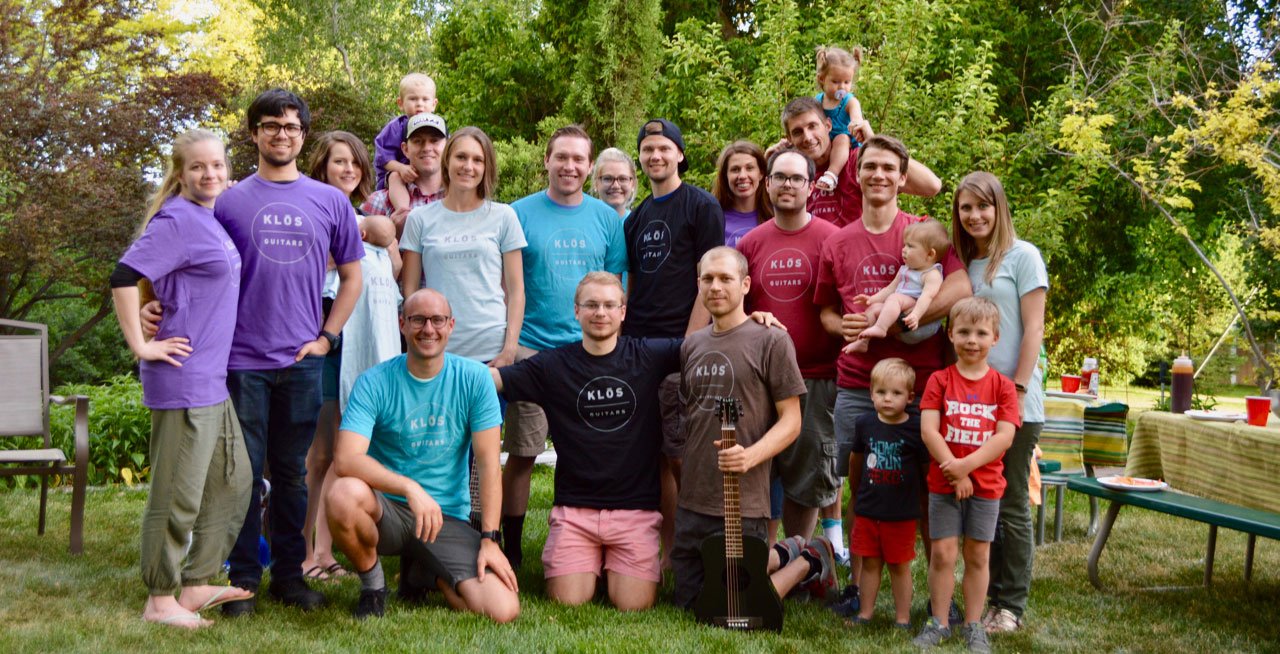
I also seek out advice from people that I really respect. Also, I've been fortunate to have several friends in my network that have been helpful along the way.
Adam’s Advice For Aspiring Entrepreneurs
Entrepreneurship is an excellent experience, but not for everyone
I think entrepreneurship is great. It's been one of the best experiences I've had, if not the best professional experience I've had. But I do think it's important for people to go in for the right reasons. It's definitely not for everyone.
It can be very stressful. It's not always stable. Things don't always go well. If someone knows they're the type of person that likes having a stable job and steady salary, I wouldn't recommend entrepreneurship necessarily.
Anyway, it’s a great learning experience. Many people think they’re not cut out for it, but when they give it a try it might actually be a good match.
Keep an open-mind to different learning opportunities
I can see that some people feel like they should rush into starting a company, they have to be a founder, or they have to be on the starting/founding team. But there is a lot you can learn from companies that have already started, well established, and are doing a lot of things well.
In fact, I think many times you can learn much more at a company like that, than in a small scrappy startup. If you go to a company, let's say that has 20 to 50 people, and you stay there for three years, you can learn excellent interpersonal skills, you can dip your hands in different buckets like marketing, supply chain, distribution, etc.
Oftentimes you'll be much better equipped to start your own company, than had you forced an idea three years earlier with no experience.
Add A Comment
VIEW THE COMMENTS